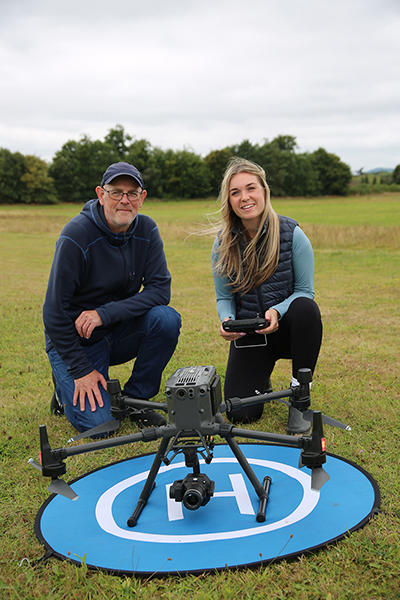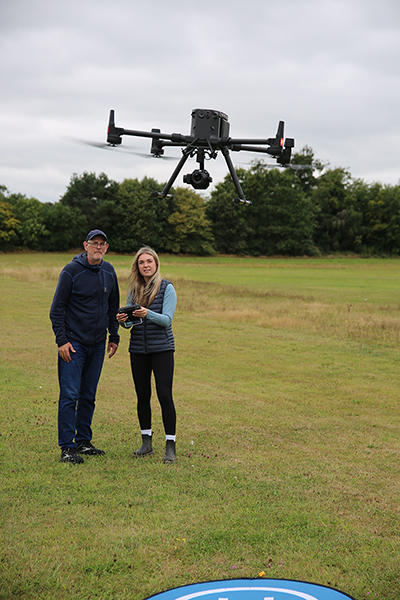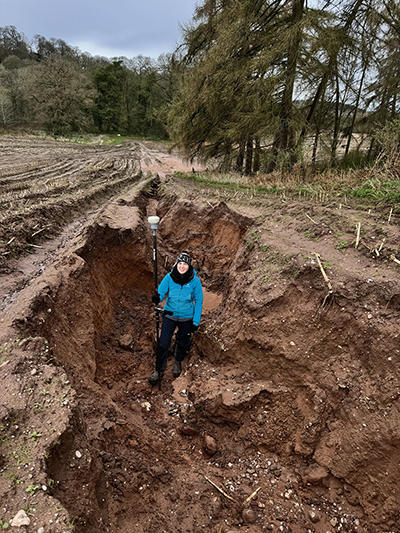Soil washed away on farmland by rainfall can have dire consequences for farmers and for the environment.
 Professor Ian Maddock (left) and PhD student and part-time research assistant Josie Lynch, from the School of Science and the Environment, with a drone
Professor Ian Maddock (left) and PhD student and part-time research assistant Josie Lynch, from the School of Science and the Environment, with a drone
Now researchers at the University of Worcester are using the latest drone technology to establish the extent of this erosion, its impact and therefore the potential cost to farmers. It is believed to be the first study of its kind to provide accurate data on the economic cost to farmers of soil erosion.
Using drones to photograph farmers’ land, Josie Lynch and Prof Ian Maddock, from the University’s School of Science and the Environment, will create high resolution 3D models, enabling them to work out how much soil has been eroded from a field. Laboratory testing of soil samples at each site will provide data on the nutrients lost associated with that soil erosion and that will allow them to calculate the economic cost of replacing these nutrients with additional fertiliser.
The researchers are taking part in a collaborative project with Natural England for the 18-month study, which is being conducted initially on four farms in the Worcestershire and Shropshire region, though it is hoped that it could be extended in the future. The project results will support Natural England’s Catchment Sensitive Farming initiative that involves working with farmers to produce food in a way that protects water, air and soil.
Ms Lynch, a part-time research assistant and part-time PhD student at the University, is lead investigator on the research. “We're going to develop a model that will provide us with detailed information of what's going on in the fields in terms of how much soil is being lost and the cost of that to farmers,” she said. “I hope that this can be rolled out more widely. If we can reduce soil erosion, it’s going to save farmers money as well as having a benefit to the environment.”

Prof Maddock, who is overseeing the research project, added: “Previous research has calculated soil erosion with drones, but hasn’t gone on to test the soil, look at the nutrients in the soil, put an economic value on that based on this and worked out the fertiliser cost to replace what is washed away in soil erosion.”
Soil erosion can be affected by rain, but also wind, snow and ice. Researchers will be looking at the nitrates, phosphates and potassium in the soil, nutrients that improve crop yields. They’ll also look at the soil itself; its density (the weight of the soil), permeability and infiltration, meaning how quickly water will drain through the soil.
Using drones make mapping the land both less time consuming and more accurate, Ms Lynch said.
Beyond the cost to farmers, the researchers say that soil erosion also has an impact on the rivers and may have consequences for the wildlife living in them.
“One of the biggest problems facing our rivers today is high phosphates,” said Prof Maddock. “Some of this comes from water treatment works. But also there is soil getting washed away and that soil has got nitrates and phosphates in it. It contains that naturally, but has increased amounts if the farmers are using the land for crop production and applying fertilisers.

If the water is high in nitrates and phosphates that can promote the growth of algae that removes some of the oxygen out of the water, and especially in summer when the water is warm, that can lead to the fish dying. The soil also settles out on the riverbed and causes declines in invertebrate populations and spawning habitat for some fish species.”
Prof Maddock added: “Climate change means we are getting more intense rainfall, and in future there are going to be more soil erosion causing events, so over time the results of this work are going to become more and more important.”
Emma Johnson, Deputy Director for Natural England in the West Midlands said: “I really welcome this project by the University of Worcester. We rely on farmers to look after this essential resource and this research will help them to do that even better. What is beneath our feet is so overlooked; we ignore soil at our peril. Soil is our lifeblood, we need healthy soil for our food, for nature, for flood prevention and to soak up carbon.”